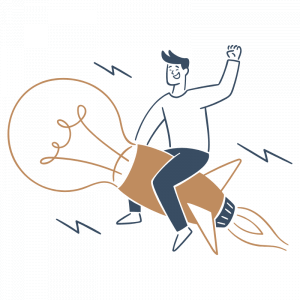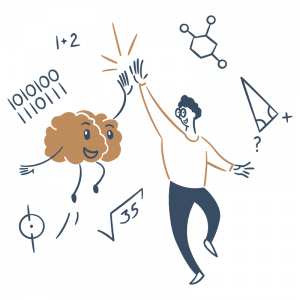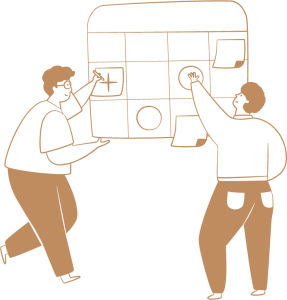In this article, you can immerse yourself with a 5-minutes read describing our five core ingredients for building a high-trust project culture, which we discovered in years of leading projects and product developments.
Let’s start with what we mean with a high-trust project culture:
To us, this is a working environment, in which all colleagues feel empowered to have their say and to grow as professionals and humans.
Since the crucial parts of cultural topics are always the concrete steps to master the journey, in the rest of this article we walk you through these five ingredients. Personally, we worked a lot with SCRUM, which is why you can directly transfer the insights of this article to your SCRUM environment. However, this is not an article about SCRUM and you can make use of our findings in non-SCRUM working environments, too. If you are interested in our views on SCRUM, we have added a small epilogue.

Ingredient 1:
Work in a rhythm of short idea-execution-feedback loops of two to four weeks. In SCRUM, these loops are called Sprints. Doing meaningful work during these short periods requires such a high communication frequency, that communication must go beyond the usual reporting meetings, management pitches, and I-know-it-all conversations, as the only remaining option to succeed. We are always striving for communication as open, honest, and respectful conversations about a joint endeavor, that all involved persons want to see succeed. In this way, communication facilitates the joint battle with the unknown for the sake of future success. When we work together with colleagues, stakeholders, and customers in such an environment over a period of time, we get to know each other beyond the surface, which is the basis for building trust. The more we know what we can expect from others, the more we know how our colleagues think and act, the more their behavior becomes transparent and predictable for us, the more we are able to build trust. In some projects, frequent communication in this sense even replaced, at least to a certain degree, rigorous processes.
Lesson from ingredient 1:
Work in short cycles, which require such a high communication frequency that people are forced to leave the usual reporting styles and management pitches in favor of open and honest conversations as the only remaining strategy that leads to joint success.
Ingredient 2:
Enforce transparency in your process, which is a pillar of SCRUM. In our projects, we keep all documents visible, and through intentional frequent meetings, the information flow is high. In SCRUM this is built-in through the SCRUM events. Following the being-open-and-transparent principle had a great effect, not just for our stakeholders. It helped the team to build trust in our project as well. Through our frequent exchange, we heard a lot from other projects and the insights gave us confidence since other teams often struggle with the same topics, which led to fruitful discussions. We also learned valuable lessons from other teams, which helped us to grow in our project. Furthermore, the received feedback became more and more motivating over time, since we systematically incorporated what we had heard in our project. Sharing these updates transparently with our feedback providers triggered a trustful collaboration.
Lesson from ingredient 2:
Consequent transparency and open sharing of the current status increases the trust of the stakeholders. Over time, this allows to speak with the humans behind the role facades, and the resulting collaboration creates a deep understanding of the topic.
Ingredient 3:
Third, we systemically attach the HOW dimension into the process. Way too often, working environments and communication are centered around the facts. However, this is not how we function as humans. SCRUM offers with its Retrospectives a dedicated meeting exactly for reflection and for shaping the project culture. We have experienced Retrospectives as a great place to express appreciation, to celebrate success, and systematically support us in the development of our strengths. These aspects cannot be overestimated in their value. To us, the crucial point is the following: Independent of our roles and hierarchy level, we can become culture creators in our projects and departments. Why? Simply because we shape the culture around us with the way how we communicate and with the communications that we omit. In particular, by omitting to express appreciation and to give supporting feedback, we actively contribute towards a cold corporate culture. Retrospectives are a great tool since the rhythm of these meetings ensures a minimum level of explicit HOW dimension in the project. However, our ultimate goal is always that Retrospectives are at one point in time no longer needed for shaping the project culture, since the HOW dimension is very visible in the daily work, see the last example below. Besides that, going together through such processes of change and personal development was for us one of the strongest foundations for building high-trust environments.
Lesson from ingredient 3:
You are the culture creator of your project. By omitting to express appreciation and to give supporting feedback, you actively contribute towards a cold corporate culture. Ensure a minimum frequency of Retrospectives (as explicit HOW dimension) in your project to build an empowering project culture.
Ingredient 4:
Developing an explicit product vision, strategy, and roadmap is essential. It gives guidance and orientation to the team and the stakeholders. This is not exclusive to projects and applies to corporate strategy, too. To us, one of the strongest motivators for teams and stakeholders is the chance to actively shape their own future. The moment, where team members and stakeholders are invited to build a joint vision, they feel heard and included. This increases self-efficacy, turns stakeholders into true partners, and makes the project for the team members to their personal endeavor. In SCRUM, the dedicated role for this task is the Product Owner.
Lesson from ingredient 4:
Use vision and strategy building as a process to develop with your team and your stakeholders joint motivation and passion. Dream the same dream as the center of gravity. Increase self-efficacy by letting your team build their own future.
Ingredient 5:
The project lead, product owner, or product manager is just a role and not THE role in the team. We are not the stars of our products. Rather, we have the most servant role for the whole team, and we are just as good as the rest of the team. This means for us, that e.g., we ask instead of telling long stories. This is important since as the project lead, product owner, or product manager, we are constantly in danger of speaking too much, rather than listening and guiding with questions. The crucial part here is to stay humble such that we remain open for contributions from stakeholders and team members.
Lesson from ingredient 5:
The project lead, product owner, or product manager is just a role, not THE role, and we are just as good as the rest of the team.
Conclusion
We hope you found value in this article for building a high-trust project culture. It is our secret sauce that we learned during years of leading projects. However, the secret sauce is actually no secret, since the above-mentioned five ingredients are publicly available and free to use. Nevertheless, in cultural topics the hard part is not the knowledge, but the daily practice. Intentionally sticking every day, even in the heat of the moment, to these five pillars is the secret behind the secret. Daily practice is king, so keep practicing and don’t lean back. It will pay off for sure.




